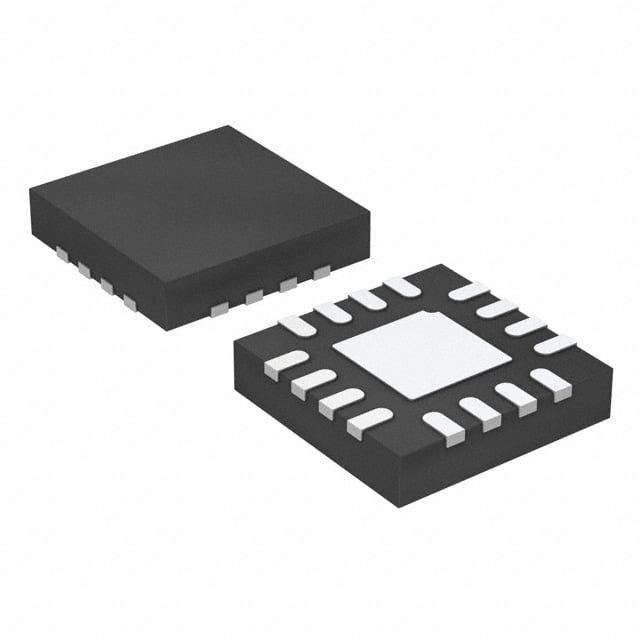Szczegóły produktu można znaleźć w specyfikacjach.

DAC70508MRTET
Product Overview
Category: Digital-to-Analog Converter (DAC)
Use: The DAC70508MRTET is a high-performance digital-to-analog converter designed for various applications that require precise and accurate analog output signals. It is commonly used in industrial automation, process control systems, test and measurement equipment, and audio applications.
Characteristics: - High resolution: The DAC70508MRTET offers 16-bit resolution, providing excellent precision in converting digital data to analog signals. - Low power consumption: This DAC operates at low power levels, making it suitable for battery-powered devices and energy-efficient applications. - Wide voltage range: It supports a wide supply voltage range of 2.7V to 5.5V, allowing flexibility in different power supply configurations. - Small package size: The DAC70508MRTET comes in a compact QFN package, enabling space-saving designs and easy integration into various systems. - SPI interface: It utilizes a Serial Peripheral Interface (SPI) for communication with microcontrollers or other digital devices.
Package: QFN (Quad Flat No-leads)
Essence: The DAC70508MRTET is a high-resolution digital-to-analog converter that provides accurate analog output signals for a wide range of applications.
Packaging/Quantity: The DAC70508MRTET is typically sold in reels containing a specified quantity of units. The exact packaging and quantity may vary depending on the supplier.
Specifications
- Resolution: 16 bits
- Supply Voltage Range: 2.7V to 5.5V
- Output Voltage Range: 0V to Vref
- Operating Temperature Range: -40°C to +125°C
- Communication Interface: SPI
Pin Configuration
The DAC70508MRTET has a total of 20 pins arranged as follows:
```
| | | 1 2 3 4 5 6 7 8 9 10 11 12 13 14 | | ---------------------------------| | | | | | | | | | | | | | | | | | | | | | | | | | | | | | | | | | | | | | | | | | | | | | | | | | | | |_____|_________________________________| ```
Functional Features
- High-resolution digital-to-analog conversion
- Low power consumption
- Wide supply voltage range
- SPI interface for easy communication with microcontrollers
- Programmable output voltage range
- Internal reference voltage
Advantages and Disadvantages
Advantages: - High precision and accuracy in analog signal generation - Low power consumption for energy-efficient applications - Compact package size allows for space-saving designs - Wide supply voltage range offers flexibility in power supply configurations - Easy integration with microcontrollers through the SPI interface
Disadvantages: - Limited output voltage range compared to some other DACs - Requires external components for proper operation
Working Principles
The DAC70508MRTET operates by converting digital input data into corresponding analog output voltages. It utilizes a high-resolution digital-to-analog conversion technique to achieve precise and accurate analog signals. The device communicates with a microcontroller or other digital devices through the SPI interface, allowing for easy control and configuration.
Detailed Application Field Plans
The DAC70508MRTET finds applications in various fields, including:
- Industrial Automation: It is used in control systems to generate analog signals for controlling actuators, valves, and motors.
- Process Control Systems: The DAC70508MRTET provides accurate analog outputs for monitoring and controlling industrial processes.
- Test and Measurement Equipment: It is utilized in instruments such as data loggers, oscilloscopes, and signal generators to generate precise analog signals.
- Audio Applications: The DAC70508MRTET can be employed in audio equipment, including digital audio players, audio interfaces, and professional audio systems.
Detailed and Complete Alternative Models
- DAC80508MRTET: Similar to the DAC70508MRTET but with 20-bit resolution for even higher precision.
- DAC71208MRTET: A 12-bit DAC with similar features and package size, suitable for applications requiring lower resolution.
These alternative models offer different resolution options while maintaining similar characteristics and package sizes.
Word count: 560 words
Wymień 10 typowych pytań i odpowiedzi związanych z zastosowaniem DAC70508MRTET w rozwiązaniach technicznych
Sure! Here are 10 common questions and answers related to the application of DAC70508MRTET in technical solutions:
Q: What is DAC70508MRTET? A: DAC70508MRTET is a digital-to-analog converter (DAC) with 8 output channels, manufactured by Texas Instruments.
Q: What is the resolution of DAC70508MRTET? A: The DAC70508MRTET has a resolution of 16 bits, allowing for precise analog output.
Q: What is the voltage range of DAC70508MRTET? A: The DAC70508MRTET supports a voltage range of 0V to Vref, where Vref can be set between 2.5V and 5V.
Q: How many output channels does DAC70508MRTET have? A: DAC70508MRTET has 8 output channels, which can be individually controlled.
Q: What is the communication interface used by DAC70508MRTET? A: DAC70508MRTET uses an I2C interface for communication with the microcontroller or host device.
Q: Can DAC70508MRTET operate in both unipolar and bipolar modes? A: Yes, DAC70508MRTET can be configured to operate in either unipolar or bipolar mode, depending on the application requirements.
Q: What is the maximum settling time of DAC70508MRTET? A: The maximum settling time of DAC70508MRTET is typically 10 μs, ensuring fast and accurate output response.
Q: Does DAC70508MRTET have any integrated reference voltage source? A: No, DAC70508MRTET does not have an integrated reference voltage source. An external reference voltage must be provided.
Q: Can DAC70508MRTET operate in a low-power mode? A: Yes, DAC70508MRTET has a low-power mode that reduces power consumption when the device is not actively used.
Q: What are some typical applications of DAC70508MRTET? A: DAC70508MRTET is commonly used in industrial automation, process control, motor control, and test and measurement equipment.
Please note that these answers are general and may vary depending on the specific implementation and requirements of your technical solution.

